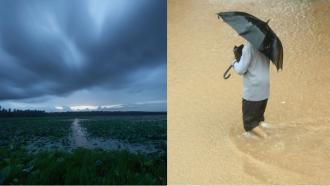
Photo : Purabi Deshpande / Research Matters
It is like asphyxia when you suddenly find yourself drowning. This is what happened to Mumbaikars on 26th July 2005. Mumbai, the city that neither sleeps nor stops, was forced to a standstill due to incessant rains. The heavy downpour made one forget the usual beauty of rains, and the city was left with only cries for help as more than a thousand people lost their lives. While this incident made Mumbai devastated, it also raised a thought about how we could prevent such tragedies in future. Thanks to researchers like Prof. Subimal Ghosh and his team at the Indian Institute of Technology – Bombay, who have been continuously working on forecasting models that can predict such heavy downpours in the hope of saving lives.
Prof. Ghosh and his Ph.D student Ms. Hiteshri Shastri, in collaboration with Prof. Subhankar Karmakar, from the Centre of Environmental Science and Engineering, IIT-B, have developed a technique that can forecast extreme rainfall events at a regional scale. They have published their new model in the Journal of Geophysical Research: Atmospheres. This model, the researchers say, is highly accurate and takes in to consideration of regional factors that influence the downpour.
“Spatio-temporal complexities of precipitation events breed uncertainties which can effectively be tackled by quantifying the predictive assessments of extreme rainfall. The technique developed by us does this using quantile regression method. Thus, it succeeds in overcoming the limitation of global models in forecasting extreme rainfall at regional scales”, says Prof. Ghosh, talking about the novelty of the newly proposed model.
But what makes predicting extreme precipitation events so complex? It is their dependence on various atmospheric processes, which occurs at different scales, say the researchers. For instance, it is a difficult task to predict extreme events when atmospheric processes associated with monsoon interact with land process associated with urban canopy. In addition, trends of extreme rainfall events are not uniform due to the influence of regional processes such as urbanization and land use change. Hence, it becomes necessary to include the most optimal set of predictor variables in the forecasting system to represent various dimensions of precipitation events, which are selected based on the conditions such as data availability.
In this model, the researchers have considered parameters like geopotential height, relative humidity, air temperature, eastward wind field, and northward wind field at pressure levels of 1000hPa and 500hPa. The model consists of two modules – the first module focuses on training and calibration of the regression model using observed/reanalyzed data and the second module applied the calculated values to the synoptic scale forecasts.
The researchers have tested the proposed model with data of Mumbai’s weather conditions to predict extreme precipitation events and found that it overcame many limitations of global models in predicting precipitation over Mumbai. The hitherto used global models forecasted precipitation events over Mumbai with a very low probability and high false alarm ratio. For comparison, the new model could forecast 17 extreme events out of 29, while the global model such as Global Ensemble Forecast System could predict only 6 events out of 29.
When asked about the applicability of this model to other regions of the country, Prof. Ghosh says, “The model can definitely be employed to forecast extreme precipitation events in other regions of India”. How about adding newer parameters to this model? “As far as possibility of including new variables is concerned to upgrade the model, it can be done according to the requirement. But, for now, the best possible set of predictors have been considered based on scientific understanding”, he adds.
Over the years, we have increasingly realized that science and technology can be a wonderful tool to serve the human society. With advances in computation and development of techniques to predict nature’s fury, there is a long way to go before man beats nature perhaps! Of course, there is so much to be done in finding such scientific solutions to serve the society. And therefore, when Prof. Ghosh says, “we are reviewing literature and working to extend our work in this direction”, it is not a surprise for sure.






